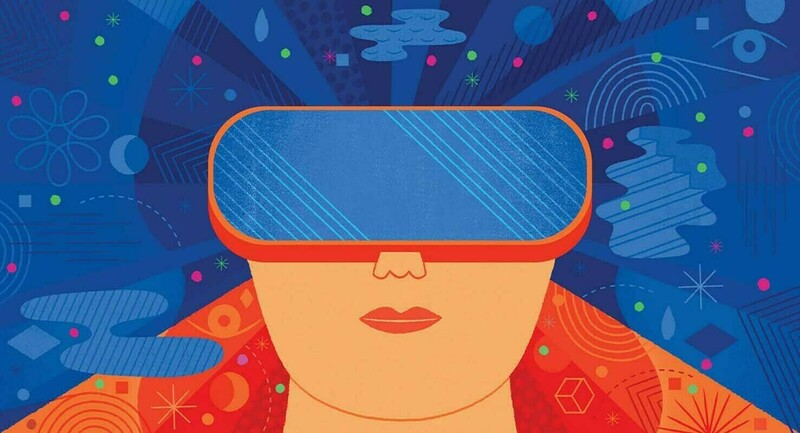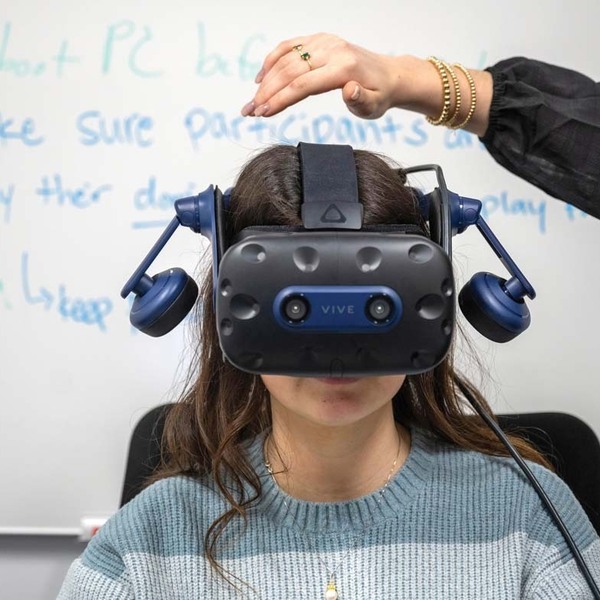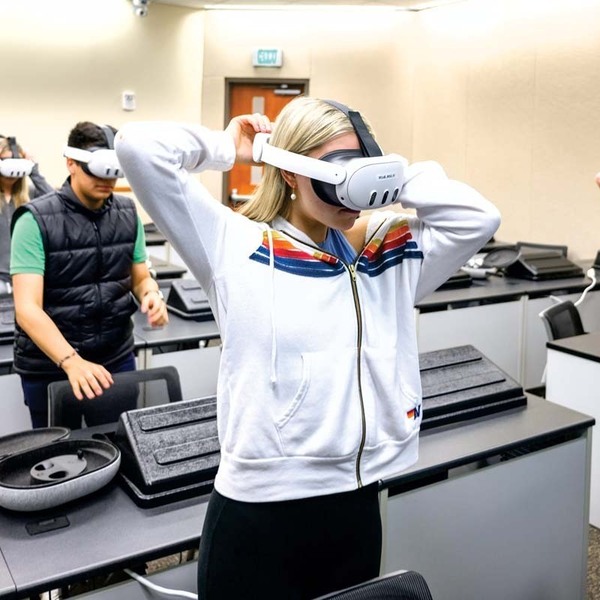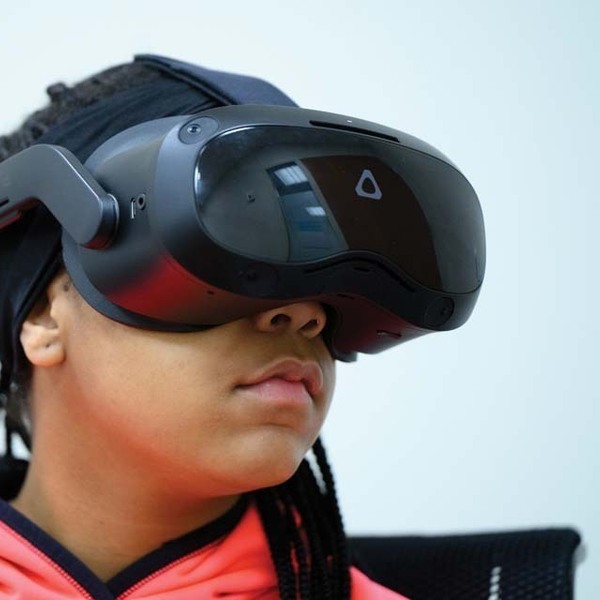 Illustration by James O’Brien
Illustration by James O’Brien
An undergraduate student in Hesburgh Library straps a white headset around her head and over her eyes . . . and steps into another world.
While studying concepts ranging from carbon-neutral architectural design to boardroom strategy to exposure therapy and beyond, Notre Dame faculty and students are donning virtual-reality headsets to immerse themselves in alternative universes.
Extended reality (XR) is one of the hottest new tools in higher education. “XR” is a catchall term that includes virtual reality, augmented reality and mixed reality, using technologies that blend the virtual and real worlds or offer a fully immersive experience.
Virtual reality (VR) gives users that immersive feel. Augmented reality incorporates computer-generated content into real-world experience — think Pokémon Go. Mixed reality technology merges those real-world and computer-generated images, like Instagram photo filters and virtual room makeovers that reimagine your home decor. But for many people, the terms don’t mean much until the first time they wear a headset and take a look for themselves.
Educational XR tools trend toward VR. They visually transport users into a different setting from the safe confines of a classroom or laboratory. Users may even take on other personas to explore how they might react to a situation if they were of a different age, race or gender.
In an introductory art class, for instance, students use the headsets to virtually draw, paint or sculpt their ideas, then share results via computer tablets. Novices must learn to think in three dimensions, and VR can help, says Justin Barfield ’13MFA, a studio art associate professor of the practice. “I love teaching in VR,” he adds. “It allows students to go through iterations of things they want to make without wasting money or materials. There’s a huge success in that.”
CEO in a boardroom
In Tim Hubbard’s strategic management course in the Mendoza College of Business, one immersive exercise places students in the position of a CEO whose company faces a public relations crisis: a top executive at the firm has been accused of sexual harassment. Standing in a virtual boardroom, in real time, the student must address seven members of the firm’s board of directors — who appear as animated figures — and is ordered to explain how the crisis will be handled. Cut to a virtual TV studio, where a journalist interrogates the student on live television about the sexual harassment problem within the firm.
“They won’t be CEOs for 20 years, but the only way to actually learn to think like a CEO is to have an idea of what the job feels like,” says Hubbard, the assistant professor of management and organization who created this VR scenario. As a co-director of the campus VR lab in Corbett Hall and the University’s first-ever XR faculty fellow, Hubbard uses VR tools for research on behavior by business leaders, the impact of boardroom diversity initiatives and related issues. He says countless other experiences may be created to help students and business executives.
For example, VR may place a student inside a scene that mimics testifying before a congressional committee. It would be expensive and unwieldy to recreate a life-size congressional hearing room for the purpose, but a VR headset can generate the scene and populate it with members of Congress who interact with each other and address questions to the would-be executive sitting in the virtual witness chair, Hubbard says.
Freshman Aleah Applin’s first VR experience came when she volunteered in one of Hubbard’s studies. “I was a little apprehensive, because most of the VR that I’ve heard of has been video games, and I’m not super into video games,” she says.
Nevertheless, she enjoyed the experience. Using VR in a course a few times a semester adds variety to learning, Applin says. “If you have constant lectures, sometimes you’re not as engaged with the content.” She says she wouldn’t want to use VR on a regular basis, but “once in a while would be a [welcome] change of pace.”
Hubbard isn’t all about technology. His lessons are driven by class discussion. “This is about understanding problems and solving problems,” he says, “or [in research] assessing companies and trying to figure out why they’re successful or unsuccessful.”
Notre Dame faculty and staff are using and developing such tools across campus. Several gather regularly to discuss their progress and results. Within the XR faculty-interest group, the XR Collective focuses on developing and expanding XR strategy on campus. “My role within the collective . . . is to try stuff out,” says Adam Heet, a digital projects specialist at the Hesburgh Library. “You have an idea? Let’s prototype it.”
“As technology advances, it affords us the opportunity to create richer and deeper learning experiences that might not be possible otherwise,” notes KC Frye, director of creative and media in the University’s Office of Digital Learning.
Hubbard believes VR will be part of his students’ future workplace experiences. “Virtual reality is very beneficial when tasks are dangerous, rare or expensive,” he explains. It may be used to instruct mechanics who will be assembling or repairing airplanes, for example, or to train firefighters and police officers learning how to respond to emergencies and make decisions without putting their lives at risk. Even medical professionals may practice complicated procedures without requiring a human patient.
Carbon-neutral design
Ming Hu ’03M.Arch. uses VR as a tool to teach such topics as climate change, carbon-neutral development and sustainable design. In her courses, she can’t always usher students onto a jet and take them to view examples in person. Instead, she relies in part on virtual reality.
“I don’t feel traditional lecture slides are sufficient to capture these really complex topics,” says Hu, an associate professor of architecture and associate dean for research, scholarship and creative work in the School of Architecture.
VR headsets allow her students to “travel” to HafenCity, a carbon-neutral district in Hamburg, Germany. The headsets and earphones permit students to “walk” the neighborhood, to watch and listen as a virtual tour guide describes environmentally sustainable features and how they might be applied elsewhere. The students explore HafenCity’s heat and power plant, a university building, a community green and other places.
Hu partnered with the Office of Digital Learning to create the HafenCity scenario, which she has now used with her students in two semesters. Now she’s adding interactive elements. She sees strengths and weaknesses in VR, just like any emerging technology. A team drawn from various disciplines can work together to determine best practices and reduce drawbacks. It’s a learning process for the academics, too, she says.
Architecture student Nico Villarreal ’24 walked through the HafenCity scenario in class last fall. He hadn’t previously used VR, but he found the technology helpful — and he’s aware of its growing use in the profession.
“It was definitely helpful to look at things from a new perspective,” he says. “It would be great if it was implemented more in a variety of classes.”
Exposure therapy
In a psychology lab in Corbett Hall, volunteer Diana A. García ’24 puts on a headset to take a music lesson. After a 10-minute VR tutorial on how to play a portion of “Minuet in G major”— a piece long mistakenly attributed to Bach — with one hand on an electronic keyboard, the scene changes.
Now she’s sitting before an audience of about 20 people — illustrated figures she sees on the screen inside the headset. On cue, García performs the music she has just learned. The “audience” is watching closely. A pulse oximeter measures García’s heart rate.
The project seeks to understand the role that such technology may play in exposure therapy for musicians prone to performance anxiety. An earlier study examined whether the technique might help people with acrophobia — the fear of heights.
Many students haven’t yet been exposed to VR, says Michael Villano ’83, a research assistant professor of psychology who is leading the study and is co-director of the virtual reality lab. “If you go into a dorm, maybe you’re going to find two or three headsets,” he says.
Her VR musical performance was fun, says García, a neuroscience and behavior major. “The difficult part was coordinating my hand and the piano in the virtual world,” because the tool didn’t allow her to see her own hands or the actual keyboard, she says.
The experiment gave García her first formal experience with VR. She says she didn’t feel nervous while playing for the virtual audience, and she’s undecided about the technology’s potential in treatment. “In neuroscience, if you picture yourself doing something and repeating and repeating, it can help you learn and develop those parts of your brain,” so perhaps VR could help patients through repeated use, she says.
Work in progress
VR has its limitations. In some scenarios, the people and scenes are simple animations that don’t look particularly life-like. Scenes may freeze and need to be repeated. Professors without coding experience require the help of tech-minded colleagues to create them.
Still, many are talking about the Apple Vision Pro — a pricey, new, mixed-reality headset — and the metaverse, a trendy term referring to virtual worlds in which users (in avatar form) interact.
Practically speaking, a reliable headset might cost about $400 — and is easily taken into classrooms. And anyone on campus may use the VR tools in the Visualization Lab, a part of the Navari Family Center for Digital Scholarship in the Hesburgh Library. Some professors send students there to participate in VR scenarios they will discuss later in class, while students often notice the lab and stop by out of curiosity.
The technology extends access to learning, says Steven Varela, the University’s director of teaching and learning technologies. “People like to call it entertainment, but it’s not. [Students] want to be engaged. They want to be pulled into something. They don’t want to be talked at,” he says. “This has always been true. The best way we learn is by doing things.”
As with other learning tools, the University evaluates VR’s classroom performance in a variety of ways, including observation, focus groups and surveys, Varela says. The goal is to pinpoint those situations in which the technology advances teaching and learning, and when other learning methods work better.
Hubbard, the business professor, recommends that those who doubt the technology try it. He likens explaining virtual reality to someone who hasn’t experienced it to trying to describe color television on the radio to somebody who’s never heard of TV.
“If you don’t put the headset on, you don’t know what’s possible,” Hubbard says. “You can’t imagine it.”
Margaret Fosmoe is an associate editor of this magazine. Contact her at mfosmoe@nd.edu or @mfosmoe.



